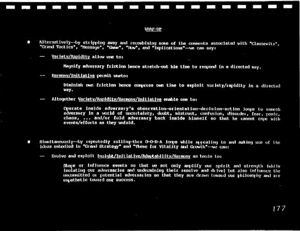Patterns of Conflict
| The works of |
| Works of John Boyd |
|---|
OODA WIKI Edition
Quantico Transcription
Okay, so now let’s look at all these things— look at all these things we’ve been talking about, Clausewitz, grand tactics, strategy, and that; remember variety and rapidity, what does that allow you to do? Variety and rapidity, in other words we’re throwing variety and rapidity at our adversary. It allows you to magnify adversary friction, stretch out his time to respond in directed ways. It will take him longer to cope.
Harmony and initiative, what that permits you to do is diminish own friction, compress own time and exploit that variety and rapidity, because you’re trying to build up this fingerspitzengefühl to a higher-level harmony, so you can exploit that relative your adversary.
So if you glue all that together, variety, rapidity, harmony and initiative together, it allows you to get inside his OODA loop. Put uncertainty, doubt, mistrust, confusion, and all that stuff we’ve been talking about into his system, or fold himself back inside himself, so he can’t cope with events as they start rolling over him, and just start scarfing him up.
And simultaneously, by looking through these things, evolve and exploit insight, initiative, adaptability as the basis to shape or influence events, et cetera. In other words, we’re looking at it from a destructive viewpoint up here, and a constructive viewpoint down here primarily.
You see the two different themes? There’s constructive themes and there’s destructive themes.
Sometimes you have to use destructive themes, or you have to use destructive themes in conjunction with constructive themes. Not just “we’re going to bomb the bastards back to the Stone Ages.” Because then they get mad and they fight longer and harder. Okay?
